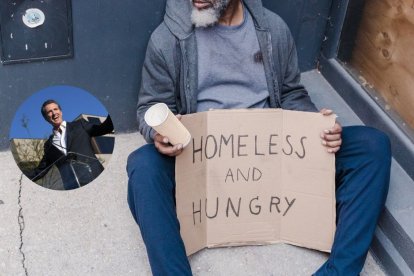California is home to one-third of all homeless people in the country
The majority of homeless people (82%) claimed to have experienced a serious mental health disorder, and a large portion identified themselves as Latino (35%), black (26%) or Native American (12%).

Voz Media (Pexels - Canva - Cordon Press)
A new study by the University of California, San Francisco revealed that, in The Golden State, more than 171,000 people live on the streets. The figure represents one-third of the country's entire homeless population:
Caspeh Report 62023 by Verónica Silveri
According to Fortune, the analysis was requested by Governor Gavin Newsom's administration and is considered the "largest representative study of homelessness in the United States since the mid-1990s." To obtain the results, more than 3,200 surveys and 365 interviews were conducted with homeless people throughout the state between October 2021 and November 2022.
The cost of housing: the main reason for homelessness
Nearly 90% of respondents cited high housing costs as the main reason they were living on the streets. California has been experiencing a housing shortage crisis for years. According to Fortune:
Caspeh Pr Final 062023 by Verónica Silveri
To combat the housing crises, the study recommended some changes to be made in the measures taken by the state administration:
- "Increase access to affordable housing for extremely low-income households."
- "Expand targeted homelessness prevention, such as financial aid and legal assistance."
- "Provide robust supports to meet the behavioral health needs of the population."
- "Increasing household incomes through evidence-based labor supports."
- "Increase outreach and service delivery to the homeless."
- "Incorporate a racial equity approach into all aspects of homeless system service delivery."
Nine out of 10 respondents claimed to be homeless due to the loss of their last home (this includes reasons such as foreclosure, default on rent payments, among others). Seventy-five percent of them lived in the same county where their last home was located.
The majority of homeless people have mental health issues
A majority of the state's homeless population is Californian. In other words, they were born and raised in The Golden State. However, a large proportion of them claimed to be part of minority ethnic groups: 35% presented themselves as Latino, 26% as black and 12% as Native American or indigenous.
Nearly half of California's homeless population is age 50 or older and the average age of respondents was 47.
The study shows that a large proportion of the homeless are people who present some type of mental vulnerability:
- The majority (82%) reported having suffered from a serious mental health illness.
- Some 27% -more than a quarter- had been hospitalized for a mental disorder.
- About two-thirds (65%) indicated that during a period in their lives they were illicit drug users. Of these, 45% said they were current users of cocaine, amphetamines and opioids.
- Sixty-two percent -almost two-thirds- reported a period in their lives when they were alcoholics.
- More than half (57%) of the users of illegal substances or excessive alcohol consumption had received medical and psychological treatment.
RECOMMENDATION





















